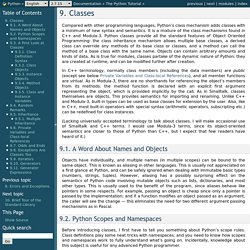Python
> Rolandstefani
> Tuts 501st
Python Django Tutorial Web Development with Python Part 2: Launching the website. Python documentation generator. How to use "map" function in Python? (How to rewrite a for loop?)
Iterator - The Python yield keyword explained. Generators. Generator functions allow you to declare a function that behaves like an iterator, i.e. it can be used in a for loop.

The simplification of code is a result of generator function and generator expression support provided by Python. To illustrate this, we will compare different implementations that implement a function, "firstn", that represents the first n non-negative integers, where n is a really big number, and assume (for the sake of the examples in this section) that each integer takes up a lot of space, say 10 megabytes each.
Note: Please note that in real life, integers do not take up that much space, unless they are really, really, really, big integers. For instance you can represent a 309 digit number with 128 bytes (add some overhead, it will still be less than 150 bytes). First, let us consider the simple example of building a list and returning it. Toggle line numbers The code is quite simple and straightforward, but it builds the full list in memory. Generators can be composed.
Programming Guides: 1 Python Generators. Python Generators. Classes. Compared with other programming languages, Python’s class mechanism adds classes with a minimum of new syntax and semantics.

It is a mixture of the class mechanisms found in C++ and Modula-3. Python classes provide all the standard features of Object Oriented Programming: the class inheritance mechanism allows multiple base classes, a derived class can override any methods of its base class or classes, and a method can call the method of a base class with the same name. Objects can contain arbitrary amounts and kinds of data.
As is true for modules, classes partake of the dynamic nature of Python: they are created at runtime, and can be modified further after creation. In C++ terminology, normally class members (including the data members) are public (except see below Private Variables and Class-local References), and all member functions are virtual. (Lacking universally accepted terminology to talk about classes, I will make occasional use of Smalltalk and C++ terms.
How to convert floating point number to base 3 in python.
Floating Point to Binary Value(C++)
Python - Float to binary. Classes (I)
Classes are an expanded concept of data structures: like data structures, they can contain data members, but they can also contain functions as members.

An object is an instantiation of a class. In terms of variables, a class would be the type, and an object would be the variable. Classes are defined using either keyword class or keyword struct, with the following syntax: Where class_name is a valid identifier for the class, object_names is an optional list of names for objects of this class. Classes have the same format as plain data structures, except that they can also include functions and have these new things called access specifiers. Private members of a class are accessible only from within other members of the same class (or from their "friends").protected members are accessible from other members of the same class (or from their "friends"), but also from members of their derived classes.Finally, public members are accessible from anywhere where the object is visible.
Constructors.



